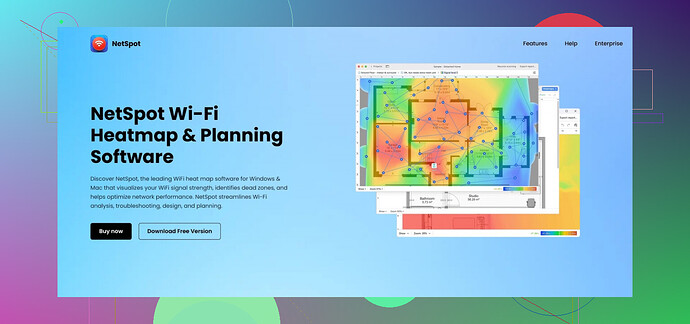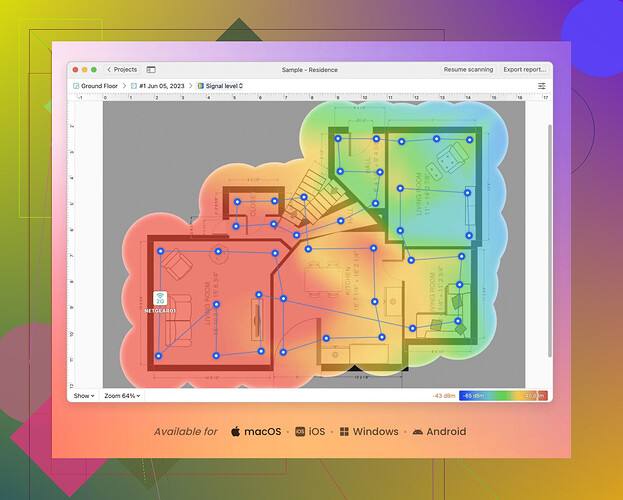I’m struggling with wifi connectivity in certain areas of my home and need recommendations for reliable wifi heatmap software. I want to identify dead zones and optimize my network. Can you suggest tools that are user-friendly and accurate?
The Ultimate Guide to WiFi Heatmap Software for Home, Small Business, and Enterprise
At its core, WiFi heatmap tools let you visualize signal strength, detect dead spots, and optimize your WiFi setup for better coverage and performance. Whether you’re setting up a network in your home, managing office connectivity, or maintaining a robust system in an enterprise environment, here’s a list of the most effective WiFi heatmap tools. We’ve compared the pros, cons, suitability, and key features of each to help you pick the best one.
1. NetSpot: A Versatile Solution for All Types of Users
Why It’s Great:
- User-Friendly: With an intuitive interface, NetSpot is ideal for both beginners and pros.
- Versatility: Suitable for home setups, small businesses, and large enterprises.
- Cross-Platform Support: Available on Windows and macOS.
Room For Improvement:
- The free version caps survey points, making it less suitable for extensive projects.
- Advanced insights require upgrading to the paid version.
The Verdict:
If you’re looking for a tool that’s perfect for various environments and skill levels, NetSpot is an excellent pick. Simple enough for first-timers yet powerful for expert use.
2. Ekahau AI Pro: The Best for Enterprise-Level Demands
Why It’s Ideal for Enterprises:
- AI-Powered Precision: Automates WiFi planning and pinpoints troubleshooting areas.
- Advanced Tools: Detects interference and generates detailed heatmaps.
- Built with massive networks in mind.
Potential Downsides:
- Premium price tag limits accessibility.
- Professional knowledge is often required to utilize its full potential.
The Verdict:
For businesses managing extensive WiFi infrastructures, Ekahau AI Pro sets the gold standard. However, its complexities and cost make it unsuitable for homes or small businesses.
3. Acrylic Wi-Fi Heatmaps: An Affordable Pick for Small Businesses
Key Advantages:
- Budget-Friendly: Offers professional-grade visualization without breaking the bank.
- Coverage Insights: Excellent for planning AP (Access Point) placement.
Drawbacks:
- Windows-Only system may alienate Mac-based users.
- A limited free trial hinders those who want to test it thoroughly.
The Verdict:
For small businesses that need efficiency without enterprise-level pricing, Acrylic Wi-Fi Heatmaps is an outstanding compromise between cost and functionality.
4. SolarWinds Network Performance Monitor: Tailored for Large Businesses
Notable Features:
- Live Heatmaps: Monitors performance in real-time, ensuring network coverage is always optimal.
- Designed to handle large-scale networks seamlessly.
Points to Ponder:
- Requires a Windows Server setup.
- Complexity makes it impractical for individuals or smaller networks.
The Verdict:
If you’re an IT team managing enterprise-level systems, SolarWinds Network Performance Monitor offers all the tools you need. Its real-time monitoring capabilities are unparalleled, though its setup demands expertise.
5. VisiWave Site Survey: The Champion for Indoor and Outdoor Use
Why It’s Unique:
- Comprehensive Mapping: Features 3D visualizations for more detailed insights.
- Works with GPS, making it great for outdoor networks.
Trade-offs:
- Windows Exclusive, limiting accessibility to some users.
- Lacks continuous monitoring capabilities.
The Verdict:
Looking to map and optimize WiFi signals over a vast area, both indoors and outdoors? VisiWave Site Survey is your go-to software with outstanding features tailored for spatial analysis.
6. TamoGraph Site Survey: The Professional’s Companion
Why Pros Love It:
- Wide Compatibility: Supports older and newer WiFi standards like 802.11ax and 6GHz.
- Usable across both Windows and macOS.
What Needs Work:
- No free version available, limiting its audience.
- Doesn’t have a mobile app for on-the-go usage.
The Verdict:
A superb alternative to higher-priced corporate tools, TamoGraph Site Survey provides extensive functionality at a reasonable cost for professionals.
7. MetaGeek inSSIDer: Lightning-Fast WiFi Insights
Best Features:
- Simplifies the process of WiFi channel optimization.
- Pinpoint interference spots in a matter of moments.
Limitations:
- Does not offer a true heatmap feature.
- Only compatible with Windows systems.
The Verdict:
For quick diagnostics, MetaGeek inSSIDer performs exceptionally well. However, if you’re after detailed heatmaps, you’ll need to explore other options.
Summary: Which One Should You Choose?
- Best Overall: NetSpot
 – A universal tool for almost anyone, from homeowners to IT specialists.
– A universal tool for almost anyone, from homeowners to IT specialists. - Best for Enterprises: Ekahau AI Pro
 – Built for sophisticated and large-scale deployments.
– Built for sophisticated and large-scale deployments. - Best for Small Businesses: Acrylic Wi-Fi Heatmaps
 – Combines great value with professional outputs.
– Combines great value with professional outputs.
Each tool shines in its own way, and your choice will largely depend on your specific needs—be it affordability, scalability, or ease of use. Select wisely and enjoy seamless and efficient WiFi connectivity!
If you’re facing WiFi dead zones, you need a solid WiFi heatmap tool to pinpoint the issues. From all the recommendations out there—yes, I saw @mikeappsreviewer’s long list too—I’m going to chime in with a bit of realism.
NetSpot is a pretty fantastic choice for the average home user. It’s very user-friendly, works on both Windows and macOS (a blessing if you’re not stuck in the Windows-only world), and gives you clear visuals of what your network coverage looks like. If you’re looking for a tool that combines ease of use and smart functionality, check out NetSpot’s Wi-Fi heatmap features. Just know that the free version has limits, so for more data points or advanced diagnostics, you’ll have to pay up.
Now, if you’re feeling adventurous or want something more advanced, there’s Ekahau AI Pro. But let’s be honest—it’s overkill unless you’re managing an office building or feel like burning a hole in your pocket. I mean, AI-powered planning and troubleshooting sounds cool, but do you really need that for streaming YouTube in the basement?
For another cost-effective home use option, MetaGeek inSSIDer might interest you for quick fixes. HOWEVER, (big however) it’s more about channel interference and doesn’t really do proper heatmaps. Kind of feels like you’re missing half the story here.
Personally, I’d avoid Acrylic or VisiWave unless you’re okay with Windows-only setups; can’t speak for everyone, but why leave out Mac users in 2023?
Save yourself the headache and start with NetSpot. Intuitive, reliable, and not overloaded with features you’ll never use. Just don’t expect miracles if your router’s ancient—sometimes the problem isn’t software, it’s your grandpa tech. Time to upgrade that too, maybe?
I get it—WiFi dead spots are super frustrating, especially when you’re trying to stream, work, or game. And you’ve got a lot of solid suggestions already from @mikeappsreviewer and @chasseurdetoiles, but let me toss my two cents into the ring.
First off, NetSpot is a strong contender, and I second its recommendation. It’s got an intuitive design for heatmap creation, so even if you’re NOT a tech wizard, you can easily figure out what’s killing your signal. Plus, it works seamlessly on both Mac and Windows. That said, if you’re planning to stick with the free version, just know it has limited survey points—it’s fine for small apartments but less great for sprawling homes. If you’re serious about fixing your coverage issues, consider upgrading to unlock all its goodies. Just saying, investing a bit may save you a lot of headaches.
For more advanced options, Ekahau AI Pro is powerful but honestly feels like using a flamethrower to light a candle. It’s expensive and better suited for IT professionals or folks managing massive office buildings. If you’re just trying to Netflix in your bedroom without disconnecting every five minutes, this might be a bit… overkill. That said, if you’re into tech and have the budget to splurge, knock yourself out. You’ll feel like a WiFi Jedi with all its features.
Want something less complicated but still reliable? Acrylic Wi-Fi Heatmaps is great if you’re okay using Windows ONLY. But honestly, the platform exclusivity makes it feel like it’s still living in 2010. Same goes for VisiWave, which also falls into the ‘Windows-only’ pit. Not super practical if you’ve got a Mac or prefer cross-platform compatibility.
Now, let’s address MetaGeek inSSIDer—ehhh, it’s fine. It’s fast and great for diagnosing interference, but there’s no real heatmap functionality. It’s like bringing a toolbox to a job that requires blueprints. You COULD get by, but there are better options depending on your needs.
If you’re still confused, let me simplify it:
- Go for NetSpot to easily analyze your WiFi coverage if you want user-friendly, effective software.
- If you’re running an enterprise-level network or managing multiple floors (and have $$$ to spend), Ekahau AI Pro is your best bet.
- For budget-conscious folks on Windows, Acrylic Wi-Fi Heatmaps does the job.
Finally, quick reality check—no software can fully fix your WiFi if your router’s ancient or you’ve got concrete walls everywhere. If these tools still show dead zones, upgrading your hardware (or adding a mesh system) might be the only way to truly solve the problem.
Hold up—before getting too lost in the weeds with all the software options thrown out there, let’s simplify this. If you’re tackling dead zones in your home setup, NetSpot hits that sweet spot between ease of use and effectiveness. It’s got a super beginner-friendly interface and runs on both Mac and Windows, which instantly makes it more appealing than some Windows-only competitors (looking at you, Acrylic Wi-Fi Heatmaps and VisiWave. Come on, it’s 2023—cross-platform should be standard).
Why NetSpot Works:
-
Pros
- Heatmaps Made Simple: Literally just walk around your house with your laptop, and it maps out your WiFi coverage with clear visuals.
- Customizable Setup: Home? Business? Doesn’t matter—it scales to different environments.
- Cross-Platform: Full support for Mac and Windows without alienating half the population.
-
Cons
- Free version limitations can leave you hanging if your house is more sprawling than compact.
- To unlock better insights (like interference detection), you’ll need to spring for the paid plan.
Now, @viajeroceleste mentioned Ekahau AI Pro, which is a BEAST if you’re running a massive network. But for casual home users? Nah. Between its price and complexity, it screams ‘Too Much Tool for the Job.’ You don’t need AI-driven precision just to figure out why your Netflix buffers in the bedroom.
As for @mikeappsreviewer recommending Acrylic, it’s a fair option if you’re an advanced Windows user and want to save some cash. But really, its Windows exclusivity feels outdated.
Alternatives for Quick Mention:
- MetaGeek inSSIDer: Cool for interference spotting, but no heatmaps? Kind of defeats the purpose, doesn’t it?
- TamoGraph: Good feature set but no free tier and not mobile-friendly. Hard pass unless you love paying upfront.
Step-By-Step Thought:
- Use NetSpot’s free version to quickly visualize signal strengths. If your house setup is tricky, upgrading isn’t a bad idea—it’s cheaper than a mesh system.
- If you’re on Windows only and penny-pinching, give Acrylic Wi-Fi Heatmaps a shot.
- Still finding dead spots? Time to consider hardware upgrades (mesh systems or extenders work wonders).
Bottom line—NetSpot bridges that gap between too basic and overkill. Yes, you’ll need the premium version for larger spaces, but hey, it beats fumbling with overly complicated tools or single-platform options. Keep it simple.

